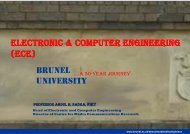DEliverable 2.3 - the School of Engineering and Design - Brunel ...
DEliverable 2.3 - the School of Engineering and Design - Brunel ...
DEliverable 2.3 - the School of Engineering and Design - Brunel ...
You also want an ePaper? Increase the reach of your titles
YUMPU automatically turns print PDFs into web optimized ePapers that Google loves.
ICT Project 3D VIVANT– Deliverable <strong>2.3</strong><br />
Contract no.:<br />
248420<br />
User Acceptance Validation Plan<br />
The most comprehensive source on how to actually conduct usability tests, which describes in all<br />
details <strong>the</strong> way <strong>the</strong> partners have organized usability tests in recent years, seems to be Rubin <strong>and</strong><br />
Chisnell’s “H<strong>and</strong>book <strong>of</strong> Usability Testing” (2008). The envisaged validation tests will try <strong>and</strong><br />
investigate differences in perceived usefulness <strong>and</strong> usability with respect to gender, age <strong>and</strong> prior<br />
experience with IT, in order to cater for varying expectations in a large (potential) audience as that <strong>of</strong><br />
<strong>the</strong> broadcasting partners in <strong>the</strong> project.<br />
2.4.1 User Acceptance <strong>and</strong> Usability<br />
The key aim <strong>of</strong> <strong>the</strong> user acceptance or usability testing is to evaluate <strong>the</strong> efficiency <strong>and</strong> effectiveness<br />
<strong>of</strong> <strong>the</strong> system. As <strong>the</strong> user interacts with a system via some form <strong>of</strong> a user interface (typically<br />
graphical), usability testing is closely associated with <strong>the</strong> study <strong>of</strong> interaction between users <strong>and</strong><br />
computers.<br />
The user acceptance <strong>of</strong> <strong>the</strong> proposed use cases (<strong>the</strong> Broadcast TV as well as <strong>the</strong> Online Hyperlinking<br />
use cases) will be tested according to <strong>the</strong> following four criteria:<br />
• Usability – Whe<strong>the</strong>r <strong>the</strong> system can be operated with ease <strong>and</strong> efficiency.<br />
• Usefulness – Whe<strong>the</strong>r <strong>the</strong> system allows <strong>the</strong> user to complete <strong>the</strong> relevant tasks successfully.<br />
• Intuitiveness – Whe<strong>the</strong>r <strong>the</strong> system <strong>and</strong> its interface components (navigation, etc.) can be easily<br />
recognised.<br />
• Learnability – Whe<strong>the</strong>r <strong>the</strong> system can be mastered quickly, minimizing <strong>the</strong> user’s learning<br />
curve.<br />
User acceptance testing will involve a mixed qualitative methodology.<br />
The user acceptance testing refers to <strong>the</strong> testing <strong>and</strong> evaluation <strong>of</strong> <strong>the</strong> developed use cases, namely <strong>the</strong><br />
Broadcast TV <strong>and</strong> Online Hyperlinking use cases as well as <strong>the</strong> 3D graphical user interface (3D GUI)<br />
that will be developed as part <strong>of</strong> <strong>the</strong>se use cases. The user acceptance testing will involve both<br />
pr<strong>of</strong>essional as well as end-users.<br />
2.4.2 Data Collection Methods<br />
The following data collection methods will be utilised to ga<strong>the</strong>r user feedback. The individual<br />
sections on <strong>the</strong> technologies (Section 3 <strong>and</strong> Section 4) to be tested will name applicable methods<br />
more precisely.<br />
• Questionnaires – Comprising <strong>of</strong> both closed <strong>and</strong> open ended questions.<br />
• Interviews – Semi-structured interviews comprising <strong>of</strong> a selected user sample <strong>and</strong> one/two<br />
interviewees.<br />
• Task-centred testing – Users fulfil prepared tasks without help from experts. Their methods <strong>and</strong><br />
success <strong>of</strong> fulfilling <strong>the</strong>se are being watched <strong>and</strong> documented.<br />
• Thinking aloud method –Users tell <strong>the</strong> tester what <strong>the</strong>y are thinking, while fulfilling tasks to<br />
give designers <strong>and</strong> developers an idea <strong>of</strong> what users would have expected.<br />
The user acceptance methodology will be employed for <strong>the</strong> testing <strong>of</strong> both components <strong>of</strong> <strong>the</strong><br />
interactive experience testing as discussed <strong>and</strong> detailed in Section 4.2.1 for <strong>the</strong> hyperlinking<br />
(particularly questionnaires, task-centred testing, <strong>the</strong> thinking aloud method <strong>and</strong> observations) <strong>and</strong><br />
Section 4.2.2 for <strong>the</strong> search <strong>and</strong> retrieval framework (particularly questionnaires, task-centred testing,<br />
<strong>the</strong> thinking aloud method <strong>and</strong> observations).<br />
Focus groups <strong>and</strong> interviews will be employed primarily for <strong>the</strong> production-side testing as described<br />
01.09.11 14
















